Arriving in Buenos Aires gives us time to unpack, wash some clothes and settle down for the next 5 or 6 days. This capital city is steeped with old European buildings, organised transport and lots of traditional cafés. The city comes alive at night. We stay at the home of Ignacio, a really nice bloke willing to offer plenty of information. His English is good too, which is a bonus. The house is 120 years old and so comfortable we know we will have trouble leaving. I'm loving having a 6 foot long hot bath to soak in after a long day walking the city.
Sundays are best to head to the SanTelmo area. It's our first real taste of Argentinean street markets along with buskers and tango dancers strutting their stuff. We walk around and watch the whole day, still a little anxious of pick pockets and scammers. It's easy to appreciate the passion of the locals. They are proud people. They love eating steaks and drinking red wine. They love football. They don't care much about their neighbours, namely Chile and Uruguay. And they are addicted to sipping on their hot herbal 'mate' drink. ( a small wooden bowl/ cup filled with a green herb. Poor in a little hot water and sip through a thin metal straw. Tastes a bit like lawn clippings!)
Another day is spent walking to Recoleta, famous for its cemetery. Never quite seen one this impressive. Large monumental tombs are resting places for many Argentinean dignitaries.
We settle into Buenos Aires easily, becoming more comfortable navigating the city, exchanging money ( getting the black market exchange rate) and catching the odd bus or subway train. Apart from dodging all the dog shit on the footpath and street walls covered in graffiti we like Buenos Aires as a city. Time to move on down through South America. To reach our destination in Southern Patagonia means another 2500 km travel, using buses and boats. We start with a 20 hour bus trip down and across to Bariloche.

The scenery changes as we approach Bariloche. With the Andes mountain range on our doorstep we know we are about to enter snow and ice country. Bariloche is reminiscent of a Swiss town, with stone and wood chalet style buildings. If you like chocolate this is the place for you. I've never seen so many chocolate shops! Buy it by weight, fill up your plastic bag and pig out!
To try and burn off all these excess calories we climb Cero Camponiero Through snow and ice we reach the summit to be welcomed with fantastic views of snow capped mountains and clear lakes all around. Then, it all disappears, as a snow blizzard cuts visibility to zero. Luckily, we are in the cafe, sipping on hot chocolate. 2 hours later we are advised to get the chairlift back down, as walking the track would be a bit dodgy. Probably get lost and freeze to death!
Our hostel in Bariloche is a party hostel. I think I'm getting too old for 3.30am bed time. It's the norm at this place... 3 nights is enough!
Which direction do we head from here? We want to head way down South Patagonia and see landscape full of ice and glaciers. Not sure if it's a good idea with winter starting to hit, and we hear many places and roads are closed already. Decide to do it, and we leave Bariloche, Argentina, and after a truly wonderful night in Villa de angostura where we wished we spent more time in this picture postcard setting we cross the border into Chile and head for Puerto Montt.
It is winter and we are finding logistics with transport and accommodation less reliable. After arriving in Puerto Montt, Chile, we book a cabin on the Navimag ship down to Chacabuca. Every piece of clothing and blankets are used in an attempt to try and keep warm as we wait to board. Hours of waiting at the dock while they load the ship. It is 3am before we walk up the truck ramp into the bowels of the ship and find our cabin. The ship is predominantly a cargo vessel carrying trucks and containers. Only a handful of passengers aboard. Sure thing, we are the only non Chilean people aboard. We carry on our own food for the 2 night trip and settle into our comfy warm cabin. (Once we turned the heater on that is) Snow covered mountains and vast expanses of icy water are all around as we make our way down through Patagonia.

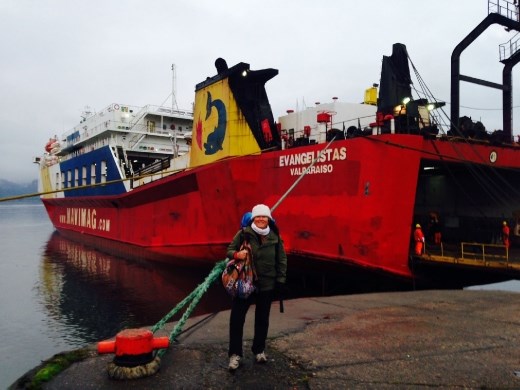
After landing in Chacabuca we need to take 2 buses to reach Coihaique, a major town and hopefully find accommodation for the night. Many of the hostels are closed for winter but we manage to find one with a TV. No heating, but a TV. Australia play Chile in the World Cup tonight, so we buy a $5 bottle of rum, rug up and settle in to watch the game. The result wasn't good for us. It was, however, good for Chile as the sounds of trumpets and car horns in the streets and shouting from the other rooms testified.
The next day we are treated to one of the most breathtaking bus rides down to Rio Tranqillo, through ice and snow on mostly gravel road. The alps of the Andes are all around... simply spectacular.
We reach the small outpost, step straight off the bus, and welcomed by the lone tour operator and before we know it we are strapping on our bright orange life jackets and climbing into his small boat to head across the lake to check out these famous marble caves. Impressive rock formations with clear aqua coloured water make for a photographers dream. It is bitterly cold as we head back across the lake into a strong headwind until we reach the small village and find a small cabana for the night. Privacy at last and before you know it I've got the combustion fire blazing and a cheap bottle of red wine 'cracked' open! Sweet dreams!
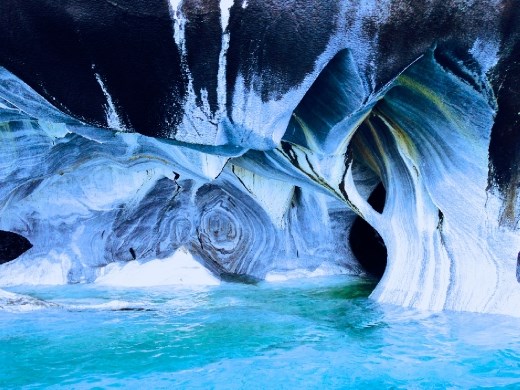
To find our way across to the border back into Argentina is a bit tricky. Because it's winter, roads further south through Chile are closed. We manage to get rides with 2 seperate mini vans, a night at a dodgy overpriced hostel in Chile Chico, and pass through the simple border post into Argentina arriving in Los Antiguos. Our plan was to catch a bus south on Ruta 40 for our final leg of our Patagonia adventure, but sure enough, the roads closed until maybe October. Well, I don't reckon we can hang around for 4 months, so we decide to take the long bus ride right back across Argentina and down the Atlantic coastline and try and reach El Calafete, almost to the bottom of South America.
Arrived at last and trudge our way from the bus terminal to the Calafate hostel. It is our base for almost a week as we set out to explore the winter wonderland on offer around us. Frozen lakes offer endless playgrounds for novice ice skaters. Dogs and kids on bikes also have fun sliding around on the ice. We just do our best to stay upright!
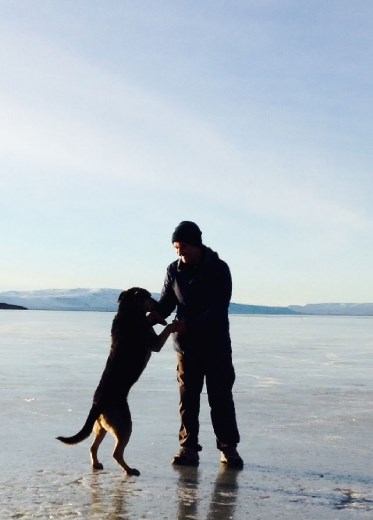
The highlight of any visit to El Calafate is the day trip to Perito Moreno glacier. Unlike most glaciers in the world, this one is advancing at a rate of 2 metres per day, and also breaking off about 2 metres every day. So it remains pretty much in the same place. You get up nice and close and witness the roar of large chunks of ice breaking away and crashing into the water below. I was lucky enough to capture a magic moment on video. An avalanche of ice breaking off the glacier sent out this tremendous roar. This glacier is huge. 35 km long , 5 km wide and about 80 m high. It is one of those natural wonders you simply stand in front of, transfixed, watch and become mesmerised by its majestic beauty.
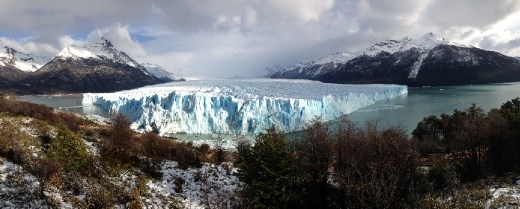

We are acclimatising to the below zero temperatures in this part of the world and decide to leave our big backpacks at the hostel in El Calafate and catch a bus a short 3 hour trip to El Chalten. Weather is on our side for the next few days and we get to hike through Argentina's treasure. Parque Nacional Los Glaciers, a national park with mountain views to die for.
We manage to chalk up nearly 40km over the next 3 days, much of it through snow and ice tracks. Hardly anyone here. Mount Fitzroy looks down upon us with condors circling above. Bright blue glaciers, frozen lakes and rivers and scattered pine forests all around. Silence. Maybe the sound of a woodpecker tapping away on a nearby tree trunk. Our bodies are sore and tired by day 3, so we treat ourselves to a couple of thick steaks and more red wine. It is Argentina you know!

There are definite benefits travelling during the off season. Buses are nearly empty. Apart from many hostels and shops being closed, we find it less crowded and so much cheaper. Rather than paying for a double bed room, we usually opt for a cheaper dorm bed, knowing we will have the room to ourselves, at half the price. The kitchens allow us to self cater and often provides entertainment, rather than being waited upon all the time. Younger backpackers become our brief friends as we go from one hostel to the next. It is good to share travel tips and stories along the way. My Spanish is still terrible so I'm happy to let Leeanne do most of the talking. We always manage to find our way around without the need for English. (But it's good when it comes along, especially when we come across fellow Aussie travellers )
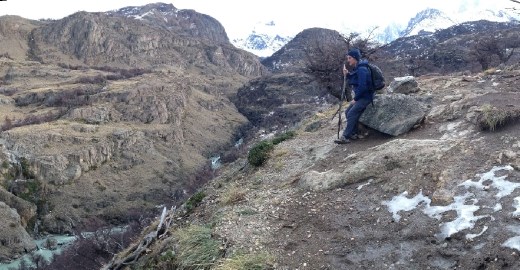
We are not quite finished with our Patagonia adventure just yet and decide to head to Puerto Natales Chile to see the famous Torres Del Paine national park. After arriving at the bus station we walk around the quiet streets for an hour or so looking for an open hostel. The town feels like a ghost town... Everything closed, people inside watching Chile play Netherlands in the World Cup. This is important stuff, and they don't want to be disturbed! We finally find a homely, warm hostel , opt for a cheap form room, and settle in for 3 days to explore the natural wonders on offer in this isolated part of the world.
We team up with our new friends, a couple from Basque Country (Spain).
The 4 of us hire a local guide for the next 2 days. He takes us into the national park and shows us caves featuring prehistoric archeology. We stop lots to take in the magnificent views if the mountains, lakes and huge rock towers( from which the park is named). Snow and ice and strong winds are the norm here. We are rugged up to keep warm, our guide doesn't wear gloves and his hands still stay warm. After a lifetime growing up in this climate he is not fazed by the cold. I watch him as he casually opens his beaver skin sack in which he carries his 'mate' drink kit. The wooden cup he uses is 15 years old. Tastes better with age, he explains. He offers me some and I politely decline. Looking above us we spot numerous condors gliding by. They have 3 metre wing spans, huge birds.
The highlight of our tour is the walk out to Grey Glacier. The glacier itself is difficult to reach but we do get up and close to the huge icebergs, broken pieces of glacier. which have floated down the lake until they become beached in the volcanic black shoreline. The colour is intense. Bright blue caused by thousands of years of ice compression. I take off my gloves for a brief few minutes and walk to the shoreline and pick up a chunk of ice. Not everyday you get to chew on a piece of glacier ice!
Leaving the park and heading back to Puerto Natales we see wild llamas, skunks and more condors. Not to mention the 2 large hares we run over ( more road kill for the condors to feed on).
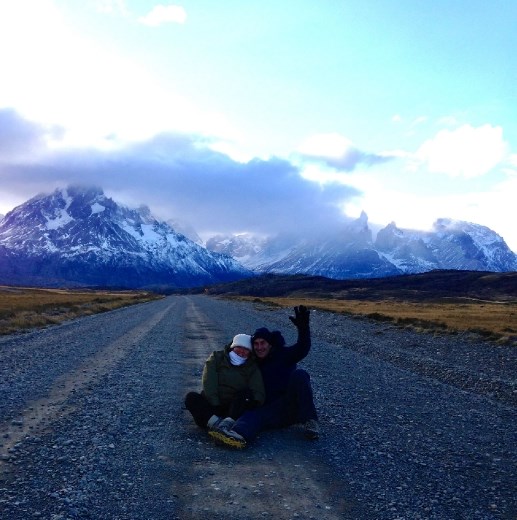
Our time is up in Patagonia. We say our goodbyes to our travel friends, and jump on a flight north to Sandiago Chile and straight on an overnight bus to Copiapo, why? because it breaks the trip up. We arrive at 8am and it's cold at the bus terminal. Next bus to San Pedro de Atacama isnt until 10.30pm so we buy our tickets, store our backpacks at the terminal and head over to the coastal town of Caldera to fill in the day. A fishing port with real Chilean fisherman. The boats are unloading massive swordfish onto the docks, with dogs fighting for scraps and fisherman laughing and joking with each other. Wish I could understand what they're saying!
The day warms up and we soak up the sunshine and shed layers of clothes, it feels good after weeks of cold. The Chilean climate in winter is dry and warm during the day and really cold, almost zero, at night. The landscape is arid and dusty, with the Andean mountain range always just over your shoulder.
Finally arrive in San Pedro. It's been 3 nights without a bed or shower. Feeling exhausted. We can't check into our hostel quick enough and clean up and jump into bed ( it's midday!). 3 days here gives us time to enjoy this small Chilean desert town, an outpost offering unique tours to surrounding sights including salt lakes, geysers, coloured rock formations and volcanoes reaching almost 6000metres. This is the driest desert in the world. Hard to find any vegetation here. So barren and harsh. but still increibly beautiful. A religious festival is happening for the few days we are here. We get to watch dancers and drummers and flute players doing their thing through the narrow dusty streets. Everyone is encouraged to join in. A happy, fun celebration. We feel like arkward school kids forced to learn folk dancing in a PE lesson.
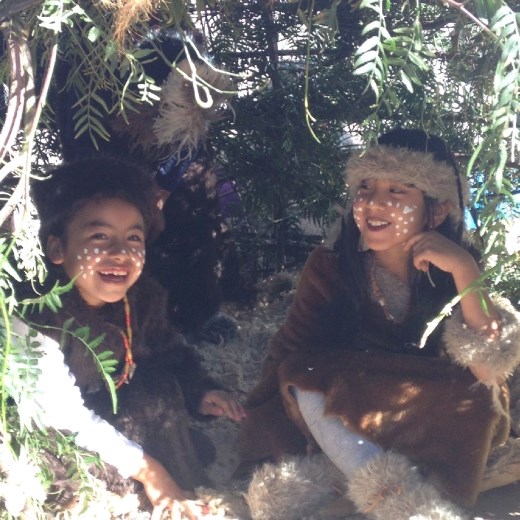
Our last day here and we decide to do a day tour to the nearby Luna Valley and Death Valley. An eerie landscape gives us plenty of photo opportunites. After walking to the top of a gorge we come across a huge sand hill, maybe 200 metres to the bottom. We run, slide and roll down getting covered in sand and dust. Reaching the bottom we dust ourselves down and look back up at this awesome sand dune. A bit further on we climb another ridge and stay until sunset and take in the 360 degree view...Andes, volcanoes, red ochre rock formations, dusty dirt tracks and little life. So quiet and surreal.
We leave San Pedro and say goodbye to Chile. A great place to visit from one end to the other, although we do find Chile more expensive than expected. Hostels and food we believe are are a little overpriced, tours arent really cheap, but bus transport is reasonable. The people are very friendly and easy to approach, and patient when it comes to communicating in our mixed 'Spanglish' language.
The bus trip over the border back into Argentina and down to Salta was worth every cent. Crossing the Andes we were treated to views to die for, for 8 hours straight! Travelling at altitudes of 5000 metres the bus winded it's way through deep canyons, perfectly shaped volcanoes, and magical coloured mountains highlighting the vast array of minerals embedded in the earth. Greens, browns, yellows, reds and oranges. It doesn't look real. A great way to arrive back in Argentina and spend our last few days in the Salta region. The small city of Salta is modern with good cheap eats ( yep, steak and red wine!). We straight away notice the cheaper prices in comparison to Chile. For a good view of the city we walk up to hundreds of steps to the lookout, stay till sunset, then head back down. Our dodgy knees are feeling a bit stiff so instead of using the stairs we decide to use the road back down. Bad move. An hour and half later we arrive at the bottom in a part of the city we a re unfamiliar with. Its dark, so we flag down a taxi and say to the driver " centro, por favor" and a few k's later we are back in familiar territory, body feeling a bit stiff.
Our only tour here in Salta is a long minivan trip to Cafayate, home of many vineyards. We dont like being cramped in a small van for a 10 hour day, but we do get to see some cool mountain ranges, colourful rock formations, and lots of tobacco farms along the way. The long trip back to Salta was painful, cramped and forced to listen to the other 12 people on board talking non stop for 3 hours, loud and in 3 different languages. Aghh!
Its our last day in Argentina before we head north over the border into Bolivia. Time is right to move on and explore a new country, one we have heard so much about and keen to experience. Since arriving in Argentina at Iguazu falls we have covered a great deal of southern South America (during winter) and feel totally in awe with the natural wonders on offer in this unique part of this amazing world. The people, the passion, the raw natural beauty is something we will never forget. "Gracias" and "Chow" Argentina and Chile. We will return!